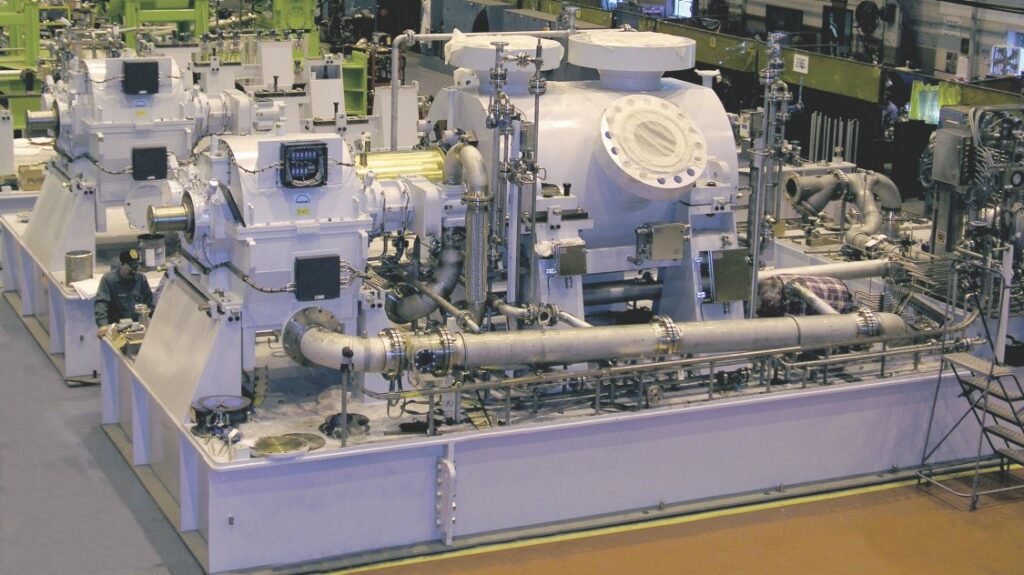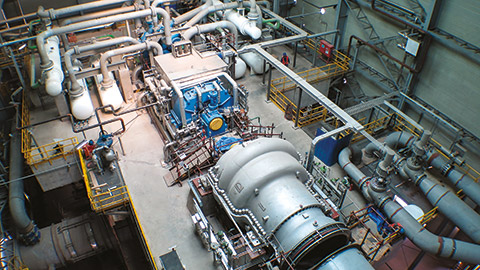FULL LOAD & FULL PRESSURE & FULL SPEED TESTING

ASME Class I Test (Type 1 per ASME PTC-10, 1997)
This test should not be confused with a full-load/full-pressure (FLFP) hydrocarbon test. This is a hydraulic performance test on the SPECIFIED gas at specified guarantee point inlet conditions and speed.
Mechanical integrity under actual performance conditions is demonstrated. The Class I test may be performed using a shop driver or the contract driver. Typically, contract lube oil and seal systems are utilized. This is a very special test with specific requirements. It is recommended that all test requirements/objectives (such as number and location of test points, acceptance criteria, gas property equations of state, speeds etc.) be identified and agreed, in writing, between the client and supplier before a final cost is estimated and quoted.
The description of the test, given below, is typical of the supplier standard offering. If any additional data points are required, they should be identified and agreed.
Typically, the supplier performs a MODIFIED Class I test. Test capabilities (ambient conditions, cooling capabilities, etc.) may dictate operation at inlet temperatures other than those specified at the guarantee conditions. Secondly, the supplier cannot typically use the exact specified gas. Most often it is a gas blend of local pipeline gas with commercially available gases such as propane, carbon dioxide and nitrogen. The gas blend is typically designed to match the specified inlet density and k value at the test inlet temperature. Under these conditions the observed values of head, pressure ratio and horsepower will be the same as observed during operation in the field under specified conditions. This test also simulates any aerodynamic excitation imparted to the rotor/bearing system relative to field operation at the specified operating conditions.
The modified Class I test is conducted at the design speed of the guaranteed condition as identified during the Class III inert gas performance test (all units subject to a Class I test shall be tested under Class III). Five data points are read from overload to within 10 % of surge (inside the proposed surge control line), units will NOT be purposely surged during this test. Units having more than one section typically will be tested one section at a time, although if the same test gas blend may be utilized in each section the supplier may consider conducting both tests simultaneously (NOTE This is at supplier’s discretion). The duration of the test is the time it takes to obtain the five data points.
If a contract driver is to be used review of the test site ambient conditions and/or facility restrictions need to be reviewed with the suppliers test department personnel. For example, a gas turbine may not be able to generate design power at the elevation and temperature of the supplier’s test facility. The steam conditions required, for a contract steam turbine, may exceed test boiler capability or electrical facilities, for a contract motor, may not be adequate.
The contract lube and seal systems may be used (or be required to be used).
Typical acceptance criteria:
Supplier typically would guarantee test results to be within the following parameters.
Observed head will be ± 4 % of specified head at the specified speed established via the Class III test.
Observed Brake Horsepower will be ± 5 % of power established by Class III test. NOT ± 5 % of guarantee horsepower. The horsepower guarantee is confirmed by the Class III test.
Typical questions:
Why is the horsepower ± 5 % of the established horsepower at specified conditions based on the Class III test and not ± 4 % of the guaranteed value?
Typically, the instrumentation used is not as accurate as the instrumentation used for the Class III test.
For example, static pressure is measured during the Class I test v. total pressure during Class III testing.
Thermowells are used instead of total temperature probes inserted directly in the gas stream. Gas property uncertainties of the specified test gas may contribute to errors. The gas properties of Class III test mediums are well known, whereas the properties of hydrocarbon mixtures are predicted.
What equations of state are used to predict the gas properties?
Supplier will evaluate various equations of state for the specified gas and select, with discussion and agreement with the client, the best equation for the particular application. Typically, BWRS (Benedict-Webb-Reuben-Starling), Lee-Kesler, SRK (Soave-Redlich-Kwong), or Peng Robinson are considered.
Will the compressor be run back into surge to establish the turndown/stability?
This is not done. To demonstrate that the unit has adequate stability a data point(s) is normally taken between the surge line and the surge control line to demonstrate stable operation.
FLFP Hydrocarbon Test
This is a mechanical integrity test and not a hydraulic performance test. This test is typically 4 hours in duration with the unit at design DISCHARGE pressure and design HORSEPOWER at MCOS (max continuous speed). Either a shop driver or the contract driver may be used. Design inlet temperature and pressure may not be the same as specified. Typically, the design molecular weight is matched by blending local pipeline gas with CO2, However a lighter than design mixture may be used to facilitate operation. For example, a mole weight less than design (or heavier) may be used to achieve both design discharge pressure and horsepower simultaneously. In some cases matching discharge pressure and
horsepower simultaneously is not possible. In these cases, the discharge pressure can usually be matched for 2 hours then the horsepower can be matched for the remaining 2 hours. Vibration acceptance levels are typically higher than those specified for the low pressure testing defined in the body of this standard.
The test is run at one operating condition throughout the test (unless discharge pressure and horsepower cannot be met simultaneously). This test also produces aerodynamic excitation imparted to the rotor/bearing system, however, the level may not be an exact match to field operation at the specified operating conditions.
If a contract driver is to be used a review of the test site ambient conditions and/or facility restrictions need to be made with the supplier. For example, a gas turbine may not be able to generate design power at the elevation and temperature of the supplier’s test facility. The steam conditions required, for a contract steam turbine, may exceed test boiler capability or electrical facilities, for a contract motor, may not be adequate.
The contract lube and seal systems may be used (or required to be used).
All test objectives and acceptance criteria need to be documented before final quotation of such a test.
Typical questions:
Will the unit be surged during the test run?
No. The unit is operated at a single flow point on the compressor map.
Will the performance of the unit be guaranteed?
No. The unit is operated at a volume reduction ratio other than design. The performance is monitored relative to the predicted performance on the test blend but no tolerances or guarantees are typically placed on the observed parameters.
FLFP Inert Gas Test
This is a mechanical integrity test NOT a hydraulic performance test. This test is 4 hours in duration with the unit at design DISCHARGE pressure and design HORSEPOWER at MCOS (max continuous speed).
Either a shop driver or the contract driver may be used. Design inlet temperature and pressure may not be the same as specified. Typically, the test molecular weight is lower than design to keep the final discharge temperature below maximum allowable levels as inert gases available have a higher K value than the design gas. In some cases matching discharge pressure and horsepower simultaneously is not possible. In these cases, the discharge pressure is matched for 2 hours then the horsepower is matched for the remaining 2 hours. Vibration acceptance levels are typically higher than those specified for the low pressure testing defined in the body of this standard.
Inert gases utilized are helium, nitrogen, helium-nitrogen mixtures, CO2 and CO2-nitrogen mixtures.
The test is run at one operating condition throughout the test. This test also produces aerodynamic excitation imparted to the rotor/bearing system; however, the level may not be an exact match to field operation at the specified operating conditions.
If a contract driver is to be used a review of the test site ambient conditions and/or facility restrictions need to be made with the supplier. For example, a gas turbine may not be able to generate design power at the elevation and temperature of the supplier test facility. The steam conditions required, for a contract steam turbine, may exceed test boiler capability or electrical facilities, for a contract motor, may not be
adequate.
Contract lube and seal systems may be used (or required to be used).
All test objectives and acceptance criteria should be documented.
Typical questions:
Will the unit be surged during the test run?
No. The unit is operated at a single flow point on the compressor map.
Will the performance of the unit be guaranteed?
No. The unit is operated at a volume reduction ratio other than design. The performance is monitored relative to the predicted performance on the test blend but no tolerances or guarantees are to be placed on the observed parameters.
Magnetic Bearing Exciter Test Option with FLFP Inert or Hydrocarbon Gas Test
This test option provides a measure of the remaining damping in a rotor/bearing system while a compressor is operating at load under inert or hydrocarbon gas test conditions with the same limitations as noted above. Several of the above tests can indicate whether a rotor/bearing system is stable at the testing conditions. This test option demonstrates, through use of a magnetic bearing exciter, the log dec remaining (stability level) in the rotor/bearing system while operating under load. The specifics of the FLFP inert or hydrocarbon gas test with magnetic bearing exciter option need to be discussed with the supplier as the test conditions may be set up slightly different to better match the field predicted aero
cross-coupling values.

